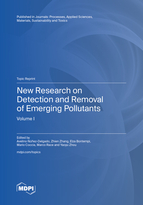Topic Menu
► Topic MenuTopic Editors






New Research on Detection and Removal of Emerging Pollutants

A printed edition is available here.
Topic Information
Dear Colleagues,
Emerging pollutants are a very relevant concern as regards environmental quality and public health. Air, soil, and water, as well as living organisms, and then the whole food chain, may be affected by these kinds of contaminants.
Some of them have been the focus of researchers for years—firstly, to detect it and then for achieving their removal or immobilization/inactivation. Both inorganic and organic emerging pollutants, as well as microbial emerging contaminants, are increasingly being considered a crucial threat for ecosystems and for a diversity of living beings, which has resulted in growing efforts and resources dedicated to lines of research in this regard. Many different aspects should be considered when evaluating these issues globally, including those in social and political fields.
The editors handling this topic cover a broad spectrum within this field of research and would like to encourage all authors interested to submit their best manuscripts related to emerging pollutants, whether research papers, reviews, short communications, perspectives, etc. The aim is to achieve a final set of papers that significantly improve the knowledge within this promising field, as well as open new views and perspectives where appropriate.
Prof. Dr. Avelino Núñez-Delgado
Dr. Zhien Zhang
Prof. Dr. Elza Bontempi
Dr. Mario Coccia
Dr. Marco Race
Prof. Dr. Yaoyu Zhou
Topic Editors
Keywords
- air pollution
- emerging contaminants
- water pollution
- sorbent materials
- soil pollution
Participating Journals
| Journal Name | Impact Factor | CiteScore | Launched Year | First Decision (median) | APC |
|---|---|---|---|---|---|

Processes
|
3.5 | 4.7 | 2013 | 13.7 Days | CHF 2400 |

Applied Sciences
|
2.7 | 4.5 | 2011 | 16.9 Days | CHF 2400 |

Materials
|
3.4 | 5.2 | 2008 | 13.9 Days | CHF 2600 |

Sustainability
|
3.9 | 5.8 | 2009 | 18.8 Days | CHF 2400 |

Toxics
|
4.6 | 3.4 | 2013 | 14.7 Days | CHF 2600 |

MDPI Topics is cooperating with Preprints.org and has built a direct connection between MDPI journals and Preprints.org. Authors are encouraged to enjoy the benefits by posting a preprint at Preprints.org prior to publication:
- Immediately share your ideas ahead of publication and establish your research priority;
- Protect your idea from being stolen with this time-stamped preprint article;
- Enhance the exposure and impact of your research;
- Receive feedback from your peers in advance;
- Have it indexed in Web of Science (Preprint Citation Index), Google Scholar, Crossref, SHARE, PrePubMed, Scilit and Europe PMC.

